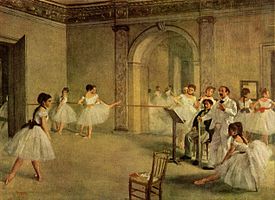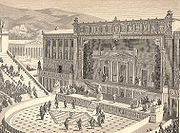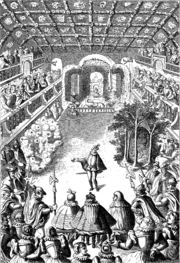Ballet
Ballet is a specific academic dance form and technique which is taught in ballet schools according to specific methods. There are many ballet schools around the world that specialize in various styles of ballet and different techniques offered. Works of dance choreographed using this technique are called ballets, and usually include dance, mime, acting, and music (usually orchestral but occasionally vocal). Ballet is best known for its unique features and techniques, such as pointe work, turn-out of the legs, and high extensions; its graceful, flowing, precise movements; and its ethereal qualities.
The Origin of Ballet
Dance is prominent throughout history. Traditions of narrative dance evolved in China, India, Indonesia and Ancient Greece. Theatrical dance was well-established in the wider arena of ancient Greek theatre. When the Roman Empire conquered Greece, it assimilated Greek dance and theatre with their art and culture.[1] While dance continued to be important throughout the Middle Ages, in spite of occasional suppression by the Church, the art of ballet did not emerge until the late 1400s in Italy. Italy began the ballet tradition, but it was the French that enabled it to blossom. Incorporating aspects of Italian ballet, French ballet gained prominence and influenced the dance genre internationally. To this day, the majority of ballet vocabulary originates from French.In the last century, the United States also developed its own ballet traditions, most notably with choreographer George Balanchine. Although interest in contemporary dance has expanded to include modern dance, jazz, flamenco and other forms, ballet has endured the test of time and is still taught and performed.
The etymology of the word "ballet" corresponds to the art form's development. The word ballet comes from French and was borrowed into English around the 17th century. The French word in turn has its origins in Italian balletto, a diminutive of ballo (dance). Ballet ultimately traces back to Latin ballere, meaning to dance.
Ballet in Italy - 'Ballo'
Ballet originated in the Renaissance court as an outgrowth of court pageantry in Italy, Aristocratic weddings were lavish celebrations. Court musicians and dancers collaborated to provide elaborate entertainment for them. Ballet was further shaped by the French ballet de cour, which consisted of social dances performed by the nobility in tandem with music, speech, verse, song, pageant, decor and costume.When Catherine de Medici, an Italian aristocrat with an interest in the arts, married the French crown heir Henry II, she brought her enthusiasm for dance to France and provided financial support.
A ballet of the Renaissance would look nothing like a performance of Giselle or Swan Lake at the Bolshoi. Tutus, ballet slippers and pointe work was unheard of. The choreography was adapted from court dance steps. Performers dressed in fashions of the times. For women that meant formal gowns that covered their legs to the ankle.Early ballet was participatory, with the audience joining the dance towards the end.
Domenico da Piacenza was one of the first dancing masters. Along with his students, Antonio Cornazano and Guglielmo Ebreo, he was trained in dance and responsible for teaching nobles the art. Da Piacenza left one work: De arte saltandi et choreus ducendi (On the art of dancing and conducting dances), which was put together by his students.
Ballet, if not the first, produced and shown was Balthasar de Beaujoyeulx's Ballet Comique de la Reine (1581) and was a ballet comique (ballet drama).In the same year, the publication of Fabritio Caroso's Il Ballarino, a technical manual on court dancing, both performance and social, helped to establish Italy as a centre of technical ballet development.
France - Courtroom Dance
Ballet developed as a separate, performance-focused art form in France during the reign of Louis XIV, who was passionate about dance and determined to reverse a decline in dance standards that began in the 17th century. King Louis XIV established the Académie Royale de la Danse (which evolved into the company known today as the Paris Opera Ballet) in 1661.The earliest references to the five core positions of ballet appear in the writings of Pierre Beauchamp, a court dancer and was a choreographer.
Jean-Baptiste Lully, an Italian composer serving in the French court, played a significant role in establishing the general direction in which ballet would follow for the next century. Supported and admired by King Louis XIV, Lully often cast the king in his ballets. The title of Sun King, by which the French monarch is still referred to today, originated from Louis XIV's role in Lully's Ballet de la Nuit (1653).Lully's main contribution to ballet was his nuanced compositions: his understanding of movement and dance allowed him to compose specifically for ballet, with musical phrasings which complemented physical movements. Lully also went on to collaborate with the French playwright Molière. Together, they took an Italian theater style, the commedia dell'arte, and adapted it into their work for a French audience, creating the comédie-ballet. Among their greatest productions was Le Bourgeois Gentilhomme (1670).Later in life, Lully became the first director of the Académie Royale de Musique after its scope was expanded to include dance.Jean-Baptiste Lully brought together Italian and French ballet, creating a legacy which would define the future of ballet.
The first ballet school was in France, and the terminology was crystallized there. Nearly everything in ballet is described by a French word or phrase. (You even wish dancers good luck in French. Actors wish one another good luck before a performance by saying, "Break a leg!" Dancers say, "Merde!" which translates, roughly, to "shit") The drawback of this is that ballerinas must learn the French names for the steps and movements; the advantage is that they can take a ballet class anywhere in the world and, no matter how unintelligible the rest of the talk is, the terminology will still be in French and therefore understood.
Russia
While France was instrumental in early ballet, other countries and cultures soon adopted the art form, most notably by Russia. Russia has a recognized tradition of ballet and Russian ballet has had great importance in its country throughout history After 1850, ballet began to wane in Paris and concentrate in Denmark and, most notably, Russia thanks to masters such as August Bournonville, Jules Perrot, Arthur Saint-Léon, Enrico Cecchetti and Marius Petipa. In the late nineteenth century, orientalism was in vogue. Colonialism brought awareness of Asian and African cultures, but distorted with disinformation and fantasy. The East was often perceived as a faraway place where anything was possible, provided it was lavish, exotic and decadent. Petipa appealed to popular taste with The Pharaoh's Daughter (1862), and later The Talisman (1889), and La Bayadère (1877). Petipa is best remembered for his collaborations with Tchaikovsky where he choreographed The Nutcracker (1892, though this is open to some debate among historians), The Sleeping Beauty (1890), and the definitive revival of Swan Lake (1895, with Lev Ivanov). These works were all drawn from western folklore.
The classical tutu began to appear at this time. It consisted of a short skirt supported by layers of crinoline that revealed the acrobatic legwork. At times the classic tutu revealed more than the audience cared to see and it became customary to wear a leotard as an undergarment.
Sergei Diaghilev brought ballet full-circle back to Paris when he opened his company, Ballet Russe. At the Ballet Russe Vaslav Nijinsky became famous for his leaps. Diaghilev and composer Igor Stravinsky combined their talents to bring Russian folklore to life in Firebird and Petrushka. The most controversial work of the Ballet Russe was Rite of Spring. Many associate Rite of Spring with the lovely time-delayed sequences of growing flowers in Fantasia but the ballet shocked audiences with its theme of human sacrifice.
After the “golden age” of Petipa, Russian ballet entered a period of stagnation. Until Michel Fokine revitalized the art. Fokine began his career in St. Petersburg but moved to the USA after the Bolshevik revolution. He felt that the ballet of the time offered little more than prettiness and athletic display. For Fokine that was not enough. In addition to technical virtuosity he demanded drama, expression and historical authenticity. The choreographer must research the period and cultural context of the setting and reject the traditional tutu in favor of accurate period costuming. Fokine choreographed Scherezade and Cleopatra and reworked Petrushka and Firebird. One of his most famous works was The Dying Swan performed by Anna Pavlova. Beyond her talents as a ballerina, Pavlova had the theatrical gifts to fulfill Fokine's vision of ballet as drama. Legend has it that Pavlova identified so much with the swan role that she requested her swan costume from her deathbed.
Russian companies, particularly after World War II engaged in multiple tours all over the world that revitalized ballet in the west and made it a form of entertainment embraced by the general public. George Balanchine brought state of the art technique to America by opening a school in Chicago and later in New York. He adapted ballet to the new media, movies and television. A prolific worker, Balanchine rechoreographed classics such as Swan Lake And Sleeping Beauty as well as creating new ballets. He produced original interpretations of the dramas of William Shakespeare such as Romeo and Juliet, The Merry Widow and A Midsummer Night's Dream. In Jewels Balanchine broke with the narrative tradition and dramatized a theme rather than a plot. Today, partly thanks to Balanchine, ballet is one of the most well-preserved dances in the world.
Barbara Karinska was an Russian emigree and a skilled seamstress who collaborated with Balanchine to elevate the art of costume design from a secondary role to an integral part of a ballet performance. She introduced the bias cut and a simplified classic tutu that allowed the dancer more freedom of movement. With meticulous attention to detail, she decorated her tutus with beadwork, embroidery, crochet and applique.
Development as an art form
The 18th century was a period of vast advancement in the technical standards of ballet and the period when ballet became a serious dramatic art form on par with the opera. Central to this advance was the seminal work of Jean-Georges Noverre, Lettres sur la danse et les ballets (1760), which focused on developing the ballet d'action, in which the movements of the dancers are designed to express character and assist in the narrative. At this time, women played a secondary role as dancers, encumbered as they were with hoops, corsets, wigs and high heels.
Reforms were made in ballet composition by composers such as Christoph Gluck. Finally, ballet was divided into three formal techniques sérieux, demi-caractère and comique. Ballet also began to be featured in operas as interludes called divertissements.
The 19th century was a period of great social change, which was reflected in ballet by a shift away from the aristocratic sensibilities that had dominated earlier periods through romantic ballet. Ballerinas such as Marie Taglioni and Fanny Elssler pioneered new techniques such as pointework that rocketed the ballerina into prominence as the ideal stage figure, professional librettists began crafting the stories in ballets, and teachers like Carlo Blasis codified ballet technique in the basic form that is still used today. The ballet slipper was invented to support pointe work.
Romanticism was a reaction against formal constraints and also of industrialization with the introduction of complex machinary and factories.The zeitgeist led choreographers to compose romantic ballets that were light, airy and fae that would act as a contrast to the reductionist science that had, in the words of Poe, "driven the hamadryad from the woods". These "unreal" ballets portrayed women as fragile unearthly beings, delicate creatures who could be lifted effortlessly. Ballerinas began to wear romantic tutus, with pastel, flowing skirts that bared the shins. The stories revolved around uncanny, folkloric spirits. An example of one such romantic ballet is "La Sylphide",one of the oldest romantic ballets still danced today.
Ballet in the late nineteenth and twentieth century

Technique

Methods
Ballet techniques are generally grouped by the area in which they originated, such as Russian ballet, French ballet, Italian ballet. Although there are some small regional variations, the 'rules' and movement vocabulary of ballet remain the same throughout the world. The different training techniques of ballet are designed to produce a different aesthetic quality from a student. This is particularly noticeable in the high extensions and dynamic turns of Russian ballet, whereas Italian ballet tends to be much more grounded, with a heavy focus on fast intricate footwork (eg. the Tarantella is a well known Italian folk dance, which is believed to have influenced Italian ballet.)
In many cases, some of the most notable ballet methods are named after their originator. In Russia for example, two of the most notable systems are the Vaganova method after Agrippina Vaganova and the Legat Method, after Nikolai Legat and in Italy, the technique is predominantly Cecchetti method after Enrico Cecchetti. Another popular European system from around the same period is the Bournonville method, which originated in Denmark and is named after August Bournonville.
Therafter of course ballet spread to other parts of the world e.g., Danish Ballet of Denmark, Imperial Ballet of UK, the American Balanchine method, the Australian Ballet and recently the National Ballet Academy & Trust set up in India.
Illusion of Flight in Ballet
To perform the more demanding routines, a ballet dancer must appear to defy gravity while working within its constraints. Basic physics and the science of human perception provide insight into how this is accomplished.
For example, during the grand jeté, the dancer may appear to hover. Physically, his/her center of mass describes a parabola, as does a ball, when thrown (or, indeed, any object when in flight and acted upon by only the gravitational force alone). However, advantage is taken of the limitation in the human ability to reckon center of mass when a projectile changes its configuration in flight. When leaping, the dancer extends the arms and legs. The manoeuvre camouflages the fall and leads the audience to perceive the dancer is floating.A Pas de Chat (step of the cat) creates a similar illusion. The dancer starts from a plié, then during the ascending phase of the step, quickly lifts each knee in succession with hips turned out, so that for a moment both feet are in the air at the same time, passing each other. For a moment, the dancer appears suspended in air.
The ability of a dancer to seemingly hold a position in mid-air is called ballon.
The fall must be performed carefully. The laws of physics decree that momentum must be dissipated but a crash landing would destroy the impression of airiness and likely injure the dancer. Part of the solution is a floor designed to absorb shock. The dancer also bends at the knees (plies) and rolls the foot from toe to heel. For artistic as well as safety reasons this technique must be taught by a qualified instructor.




